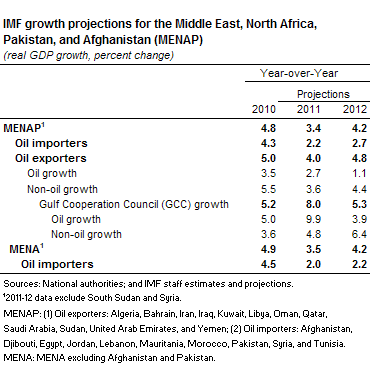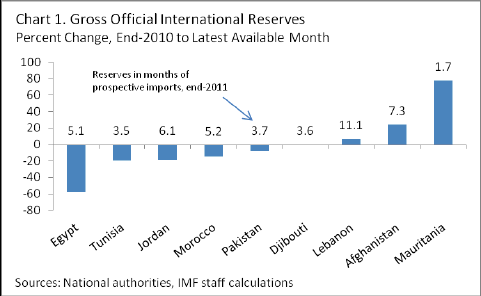A Commentary by Masood Ahmed, Director, Middle East and Central Asia Department, International Monetary Fund
Published in International Economic Bulletin, Carnegie Endowment for International Peace, May 24, 2012
The Middle East and North Africa region (MENA) is facing extraordinary challenges in the wake of the Arab Spring. The Arab countries in transition (mostly oil importers) are straining to manage political change, urgent social demands, and an adverse external environment—factors that have combined to increase the near-term risks to macroeconomic stability. These risks were also present in 2011, but now many governments have narrower margins for policy maneuver, having drawn down their foreign exchange and fiscal buffers over the past year. To manage the risks, countries in transition will need to rely on support from the international community.
Middle East oil exporters, meanwhile, are benefiting from high oil prices; it is estimated that they grew twice as fast as the region’s oil importers last year. Still, many of them face fiscal sustainability and structural challenges, including the need to create jobs for their growing working-age populations, further diversify their economies, and develop their financial markets to better support economic growth.
Oil Importers Burdened by Multiple Pressures
The region’s oil-importing countries had a difficult time in 2011.1Unparalleled domestic pressures and a challenging external environment—notably, the slowdown in global growth and higher oil prices—weighed on economic performance. Growth faltered, unemployment—already chronically high across the region—continued to rise, and government budgets stretched further. Although remittances and exports helped hold up income in many countries, foreign investment and tourism declined sharply. In addition, adverse movements in fundamentals and investor sentiment contributed to a decline in stock market indices, wider sovereign spreads, credit rating downgrades, and capital outflows from some countries.
As a result, growth for the region’s oil importers, excluding Syria, fell by nearly half from 4.3 percent in 2010 to 2.2 percent in 2011. The forecast for 2012 is only a modest recovery to 2.7 percent (see Table 1).
Syria faces exceptional circumstances—the worsening political and military conflict, apart from its tragic human costs, is likely to result in a very large decline in economic activity in 2012. Outside of the Arab countries in transition, drought in Afghanistan and floods in Pakistan played a role in those countries’ downturns.
Table 1

The months ahead will be equally challenging. That is especially true because many countries now have smaller policy buffers than they did in 2011. Last year’s policy response increased spending, which pushed up fiscal deficits and diminished external inflows. Accompanied by large current account deficits, the policies led to reserve losses (see Chart 1). And as political transitions play out, private investors will likely remain in wait-and-see mode; it will take some time for investment, tourists, and capital to return.
Moreover, the international environment remains difficult. The European Union—an important economic partner for many MENA oil importers—is projected to post near-zero growth in 2012; oil prices are expected to remain high; and spillovers from Syria could affect a number of countries in the region.

Oil Exporters Fare Well
The economies of MENA oil exporters,2 meanwhile, continue to post solid growth. While growth for the group as a whole fell from 5 percent in 2010 to about 4 percent last year (mainly due to the conflict in Libya), it reached 8 percent for the Gulf Cooperation Council (GCC).3 Oil production in GCC states increased, particularly in Saudi Arabia, to compensate for declines elsewhere (primarily in Libya). On the back of higher oil prices, the oil exporters’ combined current account surpluses approached $400 billion in 2011—almost double the amount in 2010—which helped lift their reserve position above the $1 trillion mark, support a further increase in other foreign assets, and enable stepped-up government spending.
Oil exporters’ growth in 2012 is expected to strengthen to 4.8 percent and to be more evenly spread between the GCC countries and other oil exporters, as oil prices are expected to average about $115 per barrel. In the GCC, oil and gas production is expected to remain broadly flat: Qatar’s recent rapid hydrocarbon growth is likely to tail off, pending a moratorium on capacity expansion. Saudi Arabia’s role as a swing producer, moreover, will likely entail a smaller oil production increase than was required in 2011 to keep global energy demand and supply in balance. And government spending in the GCC will continue to support growth in the non-oil sector.
Despite an overall positive outlook for oil exporters, fiscal sustainability will be an issue—even with high oil prices—for those countries already running deficits, many of which are expected to increase this year. In non-GCC countries, government spending rose by one-third in dollar terms, leading to an average fiscal deficit of 1 percent of GDP, though average oil prices exceeded $100 a barrel in 2011. GCC fiscal expenditure also rose but only by about one-fifth in dollar terms, and the twin effects of higher oil prices and large export volumes allowed GCC fiscal balances to improve. Still, overall, oil exporters’ fiscal vulnerability has increased, as the fiscal breakeven price—that is, the oil price at which a country’s fiscal accounts are in balance for a given level of spending and revenues from oil—has generally been rising over time (see Chart 2).

In addition, a number of factors could pose risks to the oil exporters’ growth scenario. The most immediate risk would be a euro-area-induced global slowdown, which would reduce global oil demand and possibly lead to a sustained drop in oil prices. This would make countries with fiscal deficits especially vulnerable.
Policy Implications
For the region’s oil-importing countries, maintaining macroeconomic stability in the current environment will be challenging. Corrective measures are needed to lessen vulnerabilities, and some steps can be taken quickly. Governments must control spending on untargeted subsidies, which predominantly benefit the wealthy, and begin putting in place more effective social safety nets to protect the poor. Central banks need to maintain external stability, which may require greater exchange rate flexibility.
Ensuring adequate financing is also a key priority. The oil importers’ external financing need will be an estimated $50 billion in 2012. Given that capital markets will not meet all of that demand, it will be important to scale up the international response.
The IMF is doing its part. It has upgraded its lending toolkit in part to address the needs of the region, approved a loan for Yemen in April, is in discussions with Egypt on a possible IMF-supported program, and is in early talks with a few other countries on financing needs and possible support. The IMF is also providing technical assistance to many countries in the region—in Egypt, for example, on tax reform to improve tax equity; in Jordan on fuel subsidy reform; in Tunisia and Morocco on measures to strengthen the financial sector; and in Yemen on improving customs administration.
But IMF support will not be enough. International and regional donors and institutions will need to provide additional funds and expertise. Improved international market access for MENA exports would also help counter the downturn in the region.
Looking further ahead, beyond macroeconomic stabilization, Arab countries in transition will need to build their own paths toward economic transformation to generate higher and more inclusive growth. Focusing on short-term macroeconomic challenges is vital. For the region’s oil-exporting countries, though there are no immediate inflationary pressures, a key short-term priority is to watch for signs of overheating in light of growing domestic demand. The quality of spending also needs to be monitored to ensure value for money in rapidly expanding public-spending programs. Reforming universal fuel price subsidies, in particular, would help contain growing domestic energy consumption. Even with high oil prices, fiscal sustainability is an issue that also needs immediate attention, especially for those countries already running deficits.
But it is equally important not to lose sight of the medium-term challenges of modernizing and diversifying the economies of the region, creating jobs outside the public sector, and providing fair and equitable opportunities for all.
Masood Ahmed is the director of the IMF’s Middle East and Central Asia Department.
This article is adapted from the IMF’s Middle East and Central Asia April 2012 Regional Economic Outlook Update and has been published with permission.
1 Oil importers include Afghanistan, Djibouti, Egypt, Jordan, Lebanon, Mauritania, Morocco, Pakistan, Syria, and Tunisia. The IMF’s Middle East and Central Asia Department includes Afghanistan and Pakistan in its analysis.
2 Oil exporters include Algeria, Bahrain, Iran, Iraq, Kuwait, Libya, Oman, Qatar, Saudi Arabia, Sudan, the United Arab Emirates, and Yemen.
3 The GCC includes Bahrain, Kuwait, Oman, Qatar, Saudi Arabia, and the United Arab Emirates.
Keine Kommentare:
Kommentar veröffentlichen